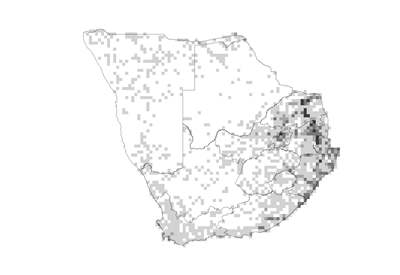 Species distribution and density. Darker squares represent higher density of members of this family. |
Introduction
Gardenia family
The fourth largest flowering plant family in the world consisting mostly of trees and shrubs (tropical) and herbs (temperate); best known for coffee, a popular drink worldwide.
Distribution
Mostly found in tropical and subtropical regions but also represented by species in temperate and cold regions. Widespread in southern Africa, but concentrated in the northeastern summer-rainfall areas.
Number of genera in the world
ca. 615
Number of species in the world
ca. 13 150
Number of genera in the Flora of southern Africa region
64
Number of species in the Flora of southern Africa region
285
Well-known southern African genera
Canthium, Gardenia, Pavetta, Vangueria
Growth forms
Mostly small trees or shrubs but also annual or perennial herbs, geofrutices, lianas and epiphytes.
Habitats
Found in arid vegetation, open scrub to forest margins, thicket and damp grassland; often the most species-rich woody plant family in tropical forest.
Flagship species
Vangueria infausta (wild medlar; wildemispel [A]; mmilo [NS]; umviyo [Z]) is a small deciduous tree found mainly on rocky hillsides in the northeastern parts of southern Africa. The leaves are velvety, often with galls on the upper surface. The fruit have a high vitamin C content and are eaten by people, birds, monkeys and antelope. Roots, fruit and leaves are used medicinally. The specific name means 'unlucky' and many people will not use the wood.
Significance of the family
An economically important family, as the genus Coffea is the main source of coffee. Members of the family also provide the dyes 'madder' (Rubia) and 'gambier' (*Uncaria). Many tropical species are cultivated as garden ornamentals (Gardenia, Rothmannia, Pavetta). Numerous taxa have local medicinal uses (Pentanisia, Rothmannia). Quinine (*Cinchona sp.) was an important malarial prophylaxis and is still used as a food and drink flavouring. Some members are toxic to livestock (Pachystigma, Pavetta). Gardenia is a source of essential oils used in the perfume industry.
Diagnostic characters
Leaves opposite, sometimes whorled, always entire, with an interpetiolar stipule � or scar; some genera have leaves with bacterial nodules � (Pavetta, Psychotria) and/or domatia � (Psydrax). Flowers regular and borne terminally or axillary; petals 4 or 5, united into a tube , with the mouth of the tube usually hairy . Ovary inferior ? with mostly 2 locules. Fruit often crowned with persistent calyx lobes .
Did you know?
*Gardenia florida, a native of China, produces an essential oil that is widely used in the perfume industry. It takes approximately three to four tonnes of flowers to produce 500 g of absolute oil.